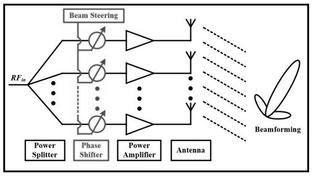Frequency Scanned Radar: Principles, Operation, and Applications
Advertisement
This page covers the fundamentals of frequency scanned radar, explaining its operation with a block diagram. The advantages and disadvantages of frequency scanned radar are also discussed.
A frequency scanned radar is a type of radar that uses frequency control of an array antenna to steer the beam. It utilizes a phased array antenna and is particularly useful for scanning the beam in one angular coordinate. This radar typically employs a series-fed array.
The following equation describes the relationship between the radar frequency and the beam scan angle:
Δλ = 2 *λo* (d/L) * sinθs
Where:
- Δλ = Wavelength change
- λo = Wavelength corresponding to the broadside direction of the beam
- d = Element spacing
- L = Length of the line connecting adjacent elements
- θs = Scan angle
Frequency Scanned Radar Operation
 Figure-1: Block diagram of frequency scanned radar
Figure-1: Block diagram of frequency scanned radar
Figure-1 shows a block diagram of a typical frequency scanned radar. As depicted in the diagram above, the frequency scanned radar incorporates various scanning techniques, including single beam scanning, multiple beam scanning, multiple frequency scan, and scanning using a reflector antenna.
The phase difference between two adjacent elements is expressed as follows:
Φ = 2 * π * f * L / v
Where:
- L = Length of the line connecting two adjacent elements
- v = Velocity of propagation
Beam steering in one dimension is achieved by changing the radar frequency. The equation for the wavelength change for a beam excursion of +/- θs is mentioned above. This frequency scanned radar often uses a folded waveguide feed, also known as a serpentine feed, as shown on the left side of the figure. This configuration is useful for scanning a pencil beam in elevation, combined with mechanical rotation to provide azimuth scan.
Advantages of Frequency Scanned Radar
- Simple in construction
Disadvantages of Frequency Scanned Radar
- Not suitable for high range resolution, ECM (Electronic Countermeasures), or pulse-to-pulse frequency agility.
- Scan angle is limited due to the potential existence of grating lobes.
- Bandwidth is limited.
- Frequency scanning in two-dimensional coordinates is not commonly used as it reduces the signal bandwidth.
Advertisement
 RF
RF

